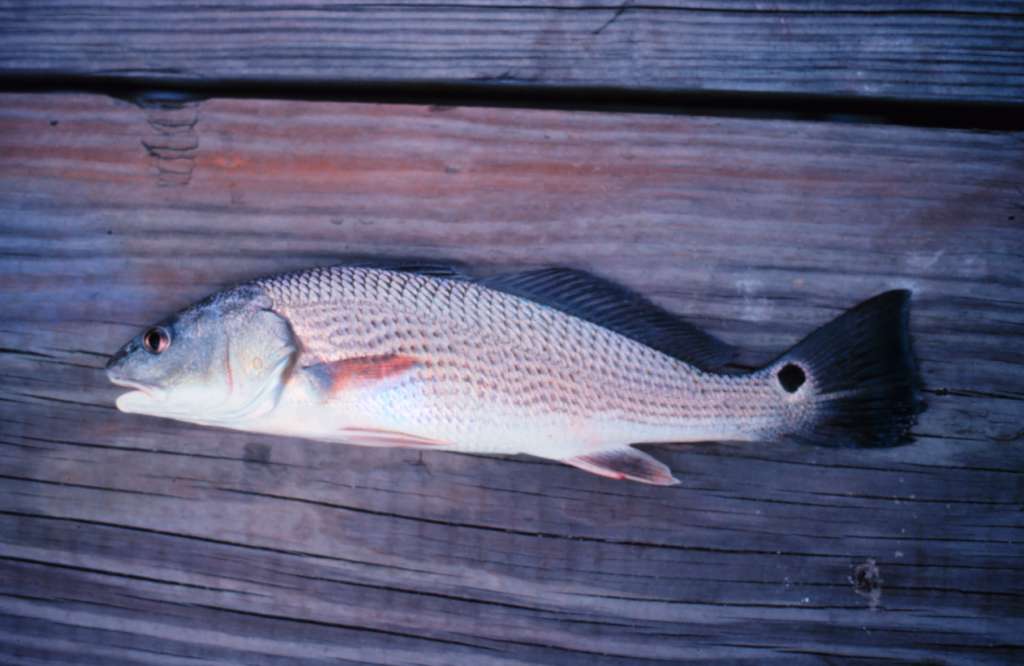
Red Drum are easily identified by their false eyespot located on the tail. Often, the tail and false eyespot break the water surface when red drum feed in shallow water. Shrimp and crabs are favorite food items of hungry red drum. Photo courtesy of NOAA. http://www.photolib.noaa.gov
Cool mornings this week reminded everyone fall is just around the corner. This subtle change in temperature inspires many of us to behave differently. It’s actually enjoyable to be outside again. Now, it’s easier to relax and drink a morning cup of pumpkin spice coffee on the porch or maybe take a brisk evening walk. These slightly cooler days not only announce the end of the dog days of summer but cue the natural world.
One of the most fascinating stories in nature unfolds this time of year. Red Drum or Redfish (Sciaenops ocellatus) are some of the most well-known and easily identified predators of the bay flats and marshes – But did you know these prized game fish can tell time? They don’t have calendars or watches but sense changes in water temperature and to the length of daylight : night time hours. Our calendar says September while their calendar says time to feed, migrate, and reproduce.
In the fish world, reproduction is known as spawning. It takes about three to four growing seasons for a red drum to mature and spawn. A mature four-year-old fish is about 28-inches in total length from head to tip of the tail. This size fish is critical to the continuation of the red drum population. This is one of the main reasons why fisheries managers regulate the number of 27 or 28-inch red drum caught. Limiting the number of this size redfish supports sustainable recruitment so there will be fish for years to come. Learn more about red drum fishing regulations by visiting Florida Fish and Wildlife at http://myfwc.com/fishing/saltwater/recreational/red-drum
When mature, red drum leave the nursery grounds of back bays and bayous and move to inlets and passes. This time of year, groups of spawning red drum may occur in entrances of the bay.
Notable members of Sciaenid or drum fish family include red drum, black drum, Atlantic croaker, and seatrout. Males have muscle fibers they vibrate against their swim bladder. The swim bladder is a hollow air filled sac fish use for buoyancy or depth control. When the muscle “strikes” the hollow sac a drum or drumming noise is created. The larger the fish the greater potential for noise. Male red drum often drum while spawning which generally occurs from sunset to sunrise.
In red drum hatcheries, light and temperature mimic the outside world and control spawning to support stock enhancement programs. In the hatchery, the drumming noise is loud and sounds like a bass drum being struck in rapid succession for about 10 seconds and then repeated. In the natural environment, Sciaenid drumming is so distinctive that researchers use hydrophones to locate and study fish species like seatrout and red drum.
While some fish species take care of their young and produce a few nurtured offspring, red drum overwhelm the odds of survival through shear numbers. During the two month spawning season, red drum spawning aggregations can produce millions of eggs each night. According to Louisiana Sea Grant, one female red drum can produce 1.5 million eggs in one night or 20-40 million per female each spawning season!
Spawning also occurs at the height of tropical storm season. Red drum eggs float on a tiny droplet of biologically produced oil that can be carried long distances by wind, waves, and water. In successful recruitment years, eggs and hatching red drum larvae make a journey into the most protected and productive portions of the bay or estuary in less than a week. Seagrass and submerged shoreline grass provide cover and protection. After rain and storms, adjacent land provides nutrients that naturally fertilize the bay waters. In response, algae and zooplankton bloom just in time to create the perfect first fish food for hatching red drum. The timing of red drum reproduction and survival is precise and elegant!
Juvenile red drum spend their next three to four-years growing to spawning adults, before migrating and starting the reproduction cycle over again.
Quick Facts: According to Texas Parks and Wildlife the oldest red drum ever recorded is 37 years old. The state record in Florida for red drum landed is just over 52 pounds and was caught near Cocoa in Brevard County, FL. A red drum caught in 1984 off the North Carolina coast holds the world record for largest red drum ever caught, 94 pounds!
An Equal Opportunity Institution. UF/IFAS Extension, University of Florida, Institute of Food and Agricultural Sciences, Nick T. Place, dean for UF/IFAS Extension. Single copies of UF/IFAS Extension publications (excluding 4-H and youth publications) are available free to Florida residents from county UF/IFAS Extension offices.
- Stem to Stern (Northwest Florida November 2, 2023) - March 28, 2024
- Gearing up for Red Snapper - July 21, 2023
- ¡Conviértase un cuidador de las vieiras (“Scallop Sitter”)! - October 7, 2022
